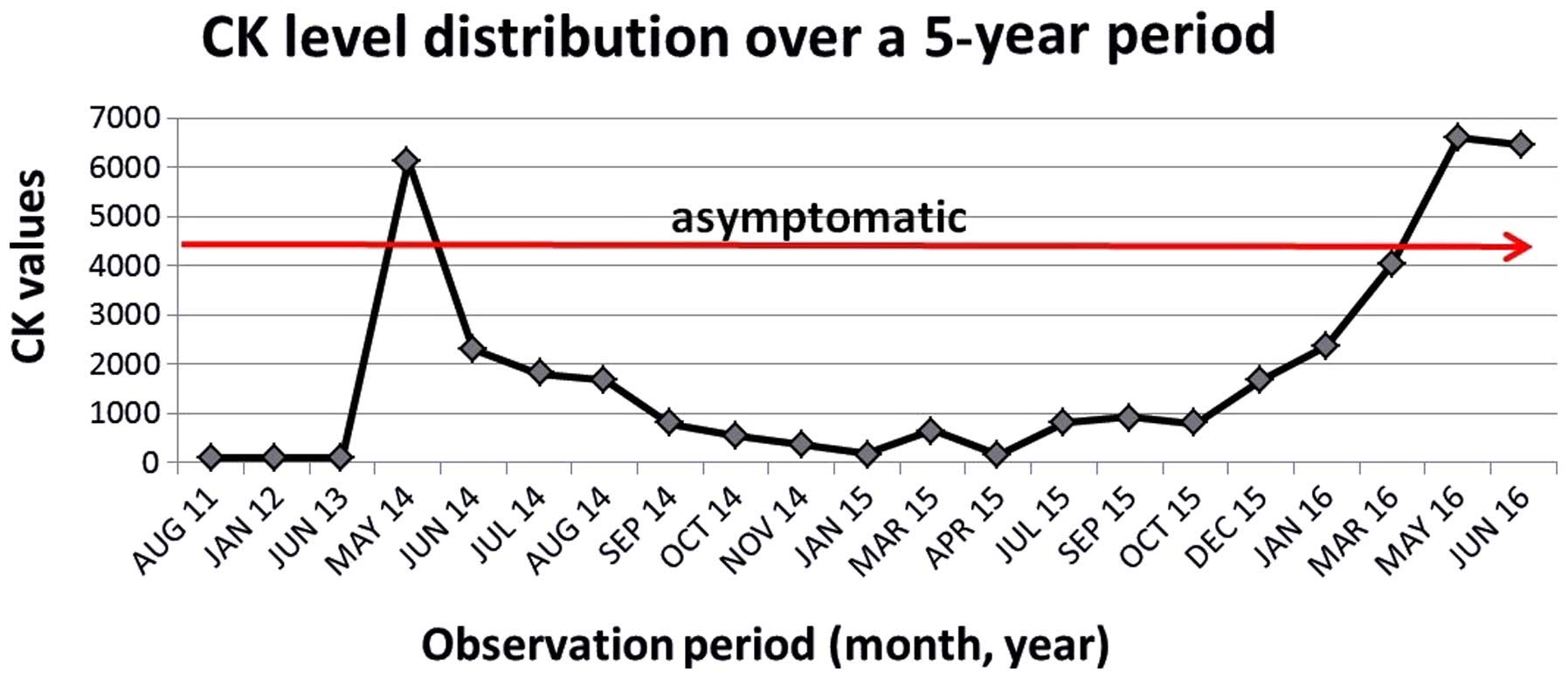|
1
|
Nanji AA: Serum creatine kinase
isoenzymes: A review. Muscle Nerve. 6:83–90. 1983. View Article : Google Scholar : PubMed/NCBI
|
|
2
|
Silvestri NJ and Wolfe GI:
Asymptomatic/pauci-symptomatic creatine kinase elevations
(hyperckemia). Muscle Nerve. 47:805–815. 2013. View Article : Google Scholar : PubMed/NCBI
|
|
3
|
Wong ET, Cobb C, Umehara MK, Wolff GA,
Haywood LJ, Greenberg T and Shaw ST Jr: Heterogeneity of serum
creatine kinase activity among racial and gender groups of the
population. Am J Clin Pathol. 79:582–586. 1983. View Article : Google Scholar : PubMed/NCBI
|
|
4
|
Kyriakides T, Angelini C, Schaefer J,
Sacconi S, Siciliano G, Vilchez JJ and Hilton-Jones D: European
Federation of Neurological Societies: EFNS guidelines on the
diagnostic approach to pauci- or asymptomatic hyperCKemia. Eur J
Neurol. 17:767–773. 2010. View Article : Google Scholar : PubMed/NCBI
|
|
5
|
Brewster LM, Mairuhu G, Sturk A and van
Montfrans GA: Distribution of creatine kinase in the general
population: Implications for statin therapy. Am Heart J.
154:655–661. 2007. View Article : Google Scholar : PubMed/NCBI
|
|
6
|
Prelle A, Tancredi L, Sciacco M, Chiveri
L, Comi GP, Battistel A, Bazzi P, Boneschi F Martinelli, Bagnardi
V, Ciscato P, et al: Retrospective study of a large population of
patients with asymptomatic or minimally symptomatic raised serum
creatine kinase levels. J Neurol. 249:305–311. 2002. View Article : Google Scholar : PubMed/NCBI
|
|
7
|
Kaushik P and Gonuguntla A: Idiopathic
Benign Hyper-CK-Emia. Int J Biomed Sci. 5:79–80. 2009.PubMed/NCBI
|
|
8
|
Rowland LP, Willner J, DiMauro S and
Miranda A: Approaches to the membrane theory of Duchenne muscular
dystrophyMuscular dystrophy-advances and new trends. Angelini C,
Danieli GA and Fontarni D: Excerpta Medica; Amsterdam: pp. 3–13.
1980
|
|
9
|
Capasso M, De Angelis MV, Di Muzio A,
Scarciolla O, Pace M, Stuppia L, Comi GP and Uncini A: Familial
idiopathic hyper-CK-emia: An underrecognized condition. Muscle
Nerve. 33:760–765. 2006. View Article : Google Scholar : PubMed/NCBI
|
|
10
|
Brewster LM and de Visser M: Persistent
hyperCKemia: Fourteen patients studied in retrospect. Acta Neurol
Scand. 77:60–63. 1988. View Article : Google Scholar : PubMed/NCBI
|
|
11
|
Reijneveld JC, Notermans NC, Linssen WH
and Wokke JH: Benign prognosis in idiopathic hyper-CK-emia. Muscle
Nerve. 23:575–579. 2000. View Article : Google Scholar : PubMed/NCBI
|
|
12
|
D'Adda E, Sciacco M, Fruguglietti ME,
Crugnola V, Lucchini V, Martinelli-Boneschi F, Zecca C, Lamperti C,
Comi GP, Bresolin N, et al: Follow-up of a large population of
asymptomatic/oligosymptomatic hyperckemic subjects. J Neurol.
253:1399–1403. 2006. View Article : Google Scholar : PubMed/NCBI
|
|
13
|
Fernandez C, de Paula AM,
Figarella-Branger D, Krahn M, Giorgi R, Chabrol B, Monfort MF,
Pouget J and Pellissier JF: Diagnostic evaluation of clinically
normal subjects with chronic hyperCKemia. Neurology. 66:1585–1587.
2006. View Article : Google Scholar : PubMed/NCBI
|
|
14
|
Dabby R, Sadeh M, Herman O, Berger E,
Watemberg N, Hayek S, Jossiphov J and Nevo Y: Asymptomatic or
minimally symptomatic hyperCKemia: Histopathologic correlates. Isr
Med Assoc J. 8:110–113. 2006.PubMed/NCBI
|
|
15
|
Joy JL and Oh SJ: Asymptomatic
hyper-CK-emia: An electrophysiologic and histopathologic study.
Muscle Nerve. 12:206–209. 1989. View Article : Google Scholar : PubMed/NCBI
|
|
16
|
Weglinski MR, Wedel DJ and Engel AG:
Malignant hyperthermia testing in patients with persistently
increased serum creatine kinase levels. Anesth Analg. 84:1038–1041.
1997. View Article : Google Scholar : PubMed/NCBI
|
|
17
|
Tachi N, Wakai S, Yutoh Y, Chiba S and
Miura J: Asymptomatic hyperCKemia: Detection of an isolated carrier
of Duchenne muscular dystrophy. J Child Neurol. 5:351–353. 1990.
View Article : Google Scholar : PubMed/NCBI
|
|
18
|
Chen D and Che G: Value of caveolin-1 in
cancer progression and prognosis: Emphasis on cancer-associated
fibroblasts, human cancer cells and mechanism of caveolin-1
expression (Review). Oncol Lett. 8:1409–1421. 2014.PubMed/NCBI
|
|
19
|
Song KS, Scherer PE, Tang Z, Okamoto T, Li
S, Chafel M, Chu C, Kohtz DS and Lisanti MP: Expression of
caveolin-3 in skeletal, cardiac, and smooth muscle cells.
Caveolin-3 is a component of the sarcolemma and co-fractionates
with dystrophin and dystrophin-associated glycoproteins. J Biol
Chem. 271:15160–15165. 1996. View Article : Google Scholar : PubMed/NCBI
|
|
20
|
Gazzerro E, Sotgia F, Bruno C, Lisanti MP
and Minetti C: Caveolinopathies: From the biology of caveolin-3 to
human diseases. Eur J Hum Genet. 18:137–145. 2010. View Article : Google Scholar : PubMed/NCBI
|
|
21
|
Carbone I, Bruno C, Sotgia F, Bado M,
Broda P, Masetti E, Panella A, Zara F, Bricarelli FD, Cordone G, et
al: Mutation in the CAV3 gene causes partial caveolin-3 deficiency
and hyperCKemia. Neurology. 54:1373–1376. 2000. View Article : Google Scholar : PubMed/NCBI
|
|
22
|
Reijneveld JC, Ginjaar IB, Frankhuizen WS
and Notermans NC: CAV3 gene mutation analysis in patients with
idiopathic hyper-CK-emia. Muscle Nerve. 34:656–658. 2006.
View Article : Google Scholar : PubMed/NCBI
|
|
23
|
Merlini L, Carbone I, Capanni C, Sabatelli
P, Tortorelli S, Sotgia F, Lisanti MP, Bruno C and Minetti C:
Familial isolated hyperCKaemia associated with a new mutation in
the caveolin-3 (CAV-3) gene. J Neurol Neurosurg Psychiatry.
73:65–67. 2002. View Article : Google Scholar : PubMed/NCBI
|










